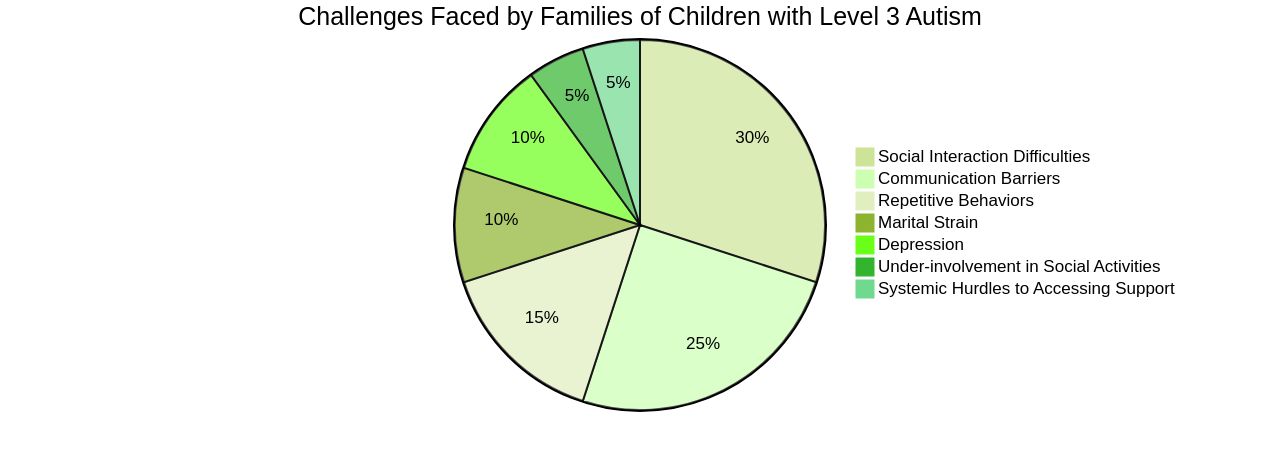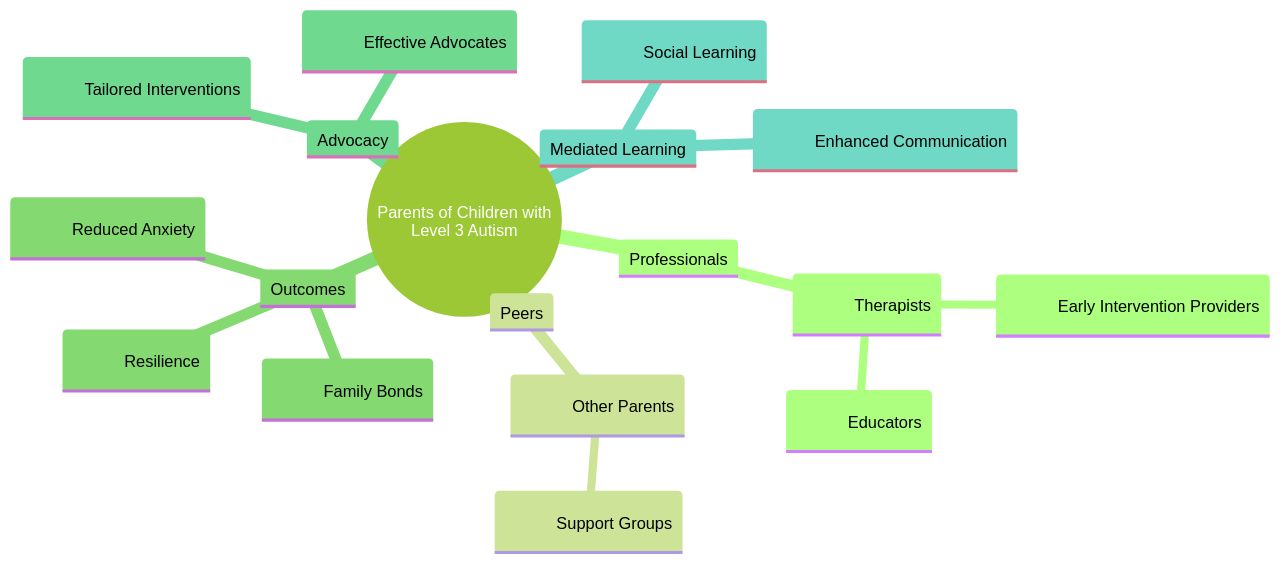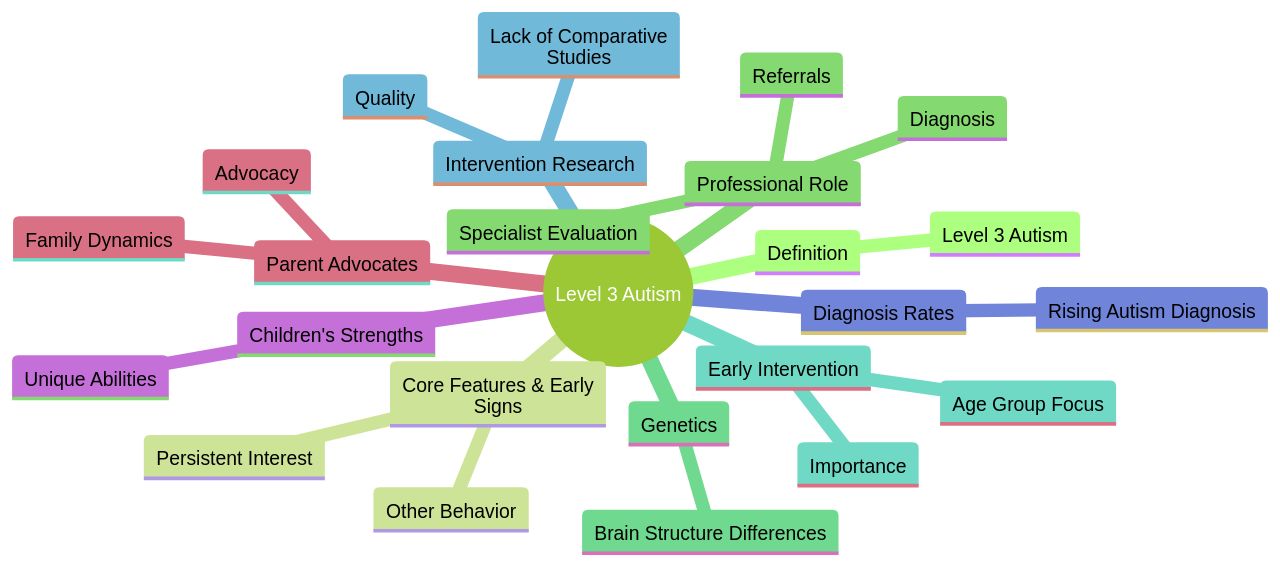Introduction
Understanding the impact of Level 3 autism on family dynamics is crucial for parents who are the pillars of support for their children. This article explores the challenges faced by families navigating Level 3 autism and offers guidance on building a support network, educating oneself, implementing individualized interventions, and prioritizing self-care. By delving into these topics, parent advocates can gain valuable insights and resources to empower them in their journey of advocating for their children's well-being.
Understanding Level 3 Autism
Understanding the impact of Level 3 autism, the most severe autism spectrum disorder (ASD), on family dynamics is crucial for parents who are the pillars of support for their children. This form of autism presents considerable challenges in social interaction, communication, and repetitive behaviors.
It requires a deep empathy for the daily lived experiences of these families, who often face additional stressors such as marital strain, depression, and under-involvement in social activities. For instance, Harrison Geraghty-Anthony's story illustrates the lengths to which parents will go to secure the necessary care for their child, even seeking treatment abroad due to local healthcare gaps.
Families navigating the complexities of ASD must often become fierce advocates for their children, fighting systemic hurdles to access the support that can fundamentally improve their child's quality of life. The developmental ecology of children with ASD—encompassing everything from neighborhood cohesion to social welfare policies—plays a significant role in their health and development.
This is further complicated by the fact that up to 70% of individuals with ASD struggle with additional challenges like anxiety and mood difficulties. Empirical data underscores the importance of early diagnosis and tailored support.
A comprehensive study has revealed a higher incidence of undiagnosed autism, particularly among adults, indicating a systemic oversight in recognizing and addressing autism across all age groups. Meanwhile, research by Boshoff et al. (2016) emphasizes the unique experiences of autistic parents advocating for their autistic children, highlighting the need for services that are attuned to the nuanced needs of these families. Above all, it is the message of hope that resonates most strongly within the autism community. As one unknown author beautifully puts it, "Every day brings a new beginning and a new ending." This sentiment captures the essence of the journey for parents of children with Level 3 autism—as each day presents its own set of challenges and triumphs, hope remains a guiding light towards a more understanding and supportive society.

Building a Support Network
Raising a child with level 3 autism presents unique challenges, often demanding a high level of care and attention. It's a journey that requires resilience and an abundance of resources. To navigate this complex terrain, forming a robust support network is not just beneficial—it's essential.
This network should include a mix of professionals—therapists, educators, early intervention providers—and peers, such as other parents who share the same path. These connections can become a wellspring of emotional sustenance, practical advice, and shared experiences, offering a sense of solidarity in the face of adversity. Studies underscore the importance of social support systems that provide emotional backing and information sharing, which are vital for the well-being of families.
They help in fortifying family bonds, mitigating anxiety, and fostering a collective resilience. Moreover, these support groups can imbue families with hope and an optimistic outlook towards the future, especially during times of crisis. Indeed, the right support can empower parents to become effective advocates for their children, ensuring access to tailored interventions that address the nuanced social communication challenges faced by children with autism.
It's important to remember that while autism's daily unpredictability can be overwhelming, there is always hope for a new beginning. As one unknown author put it, "Every day brings a new beginning and a new ending." By leveraging the unique relationship between parent and child and engaging in mediated learning approaches, parents can become the conduit for their child's social learning, ultimately enhancing the child's ability to communicate and engage with the world around them.

Educating Yourself
Understanding Level 3 Autism is crucial for parent advocates who are champions for their children's well-being. Level 3 Autism, categorized by the DSM-5, presents with severe challenges in social communication and highly repetitive behaviors. These core features are typically observed early in childhood, but may not be fully recognized until social situations become more demanding.
To ensure accurate diagnosis, children should be evaluated by professionals adept in assessing communication, behavior, and development, ideally through developmental screenings at regular health visits, recommended at 18 and 24 months. The National Institute of Child Health and Human Development (NICHD) provides a detailed list of behaviors to monitor, including communication and social behavior, which can assist parents in recognizing early signs of Autism. Furthermore, brain imaging studies reveal differences in brain structure between those with Autism and neurotypical development, dispelling myths that vaccines, parenting, or nutrition cause the condition.
Genetics play a significant role, and while no single gene has been pinpointed, the search for genetic markers continues. Parent advocates must be informed about these aspects to navigate education, therapy, and support services effectively. Evidence suggests that early intervention is critical.
However, a study led by Micheal Sandbank, PhD, at UNC School of Medicine, highlights the predominance of low-quality studies in intervention research. Sandbank urges transparency with families regarding the quality of evidence and potential unknowns regarding intervention outcomes. The CDC also reports a rise in Autism diagnosis, emphasizing the importance of early, quality intervention.
With the right support, children with Autism can leverage their unique strengths, such as a keen sense of justice, attention to detail, and deep subject matter expertise. Educational approaches like the TEACCH program capitalize on visual learning and consistency, which are often beneficial. By understanding the full spectrum of Autism and the evidence behind interventions, parent advocates can be instrumental in fostering positive outcomes and navigating the complexities of Autism in family dynamics.

Implementing Individualized Interventions
When it comes to supporting children with level 3 autism, it's essential to recognize the individuality of each child and the interventions they may require. A collaborative approach involving parent advocates and professionals is crucial to craft personalized plans that incorporate therapies such as behavioral, speech and language, occupational, and social skills training.
With recent studies underscoring the variability and lack of standardization in autism interventions, particularly for the birth to 3 age group, this tailored methodology is ever more important. As noted by experts, while there is a consensus on the importance of treatment intensity, family involvement, and a focus on generalization, the field is marked by a diversity of programs, each with its own philosophy.
This landscape demands that interventions be carefully chosen and adapted to the specific needs of very young children with social communication challenges. The evidence base for these interventions is rapidly expanding, with an increasing number of studies highlighting the effectiveness of early, developmentally appropriate, and family-empowering interventions. Furthermore, as research evolves, it's vital to stay informed about the latest evidence to ensure that recommendations for interventions reflect current knowledge and best practices, while being mindful of the potential for unknown adverse effects. Ultimately, the goal is to enhance access to high-quality, evidence-based interventions that address the core social difficulties of autism and foster optimal development.

Prioritizing Self-Care
The vitality of self-care for parent advocates cannot be overstated. Tending to your physical, emotional, and mental health is a cornerstone of resilience, enabling you to navigate the complexities of your role with grace and effectiveness. Embrace activities that rejuvenate your spirit and seek out respite care to recharge.
It's essential to remember that self-care is a crucial part of your toolkit, not a luxury. As the American Psychological Association's Mary Ann McCabe emphasizes, when a parent's well-being declines, it can hinder their capacity to support their child's development effectively. This sentiment is echoed by Christine Crawford from the National Alliance on Mental Illness, who points out that the relentless stress of caring for a child can leave parents in a perpetual state of alertness, compromising their health.
A study by Ohio State University underscores this, revealing that 57% of parents struggle with burnout, often due to the pressure of unrealistic expectations. By prioritizing your well-being, you become a beacon of strength and a role model for your children, illustrating the importance of looking after oneself. Remember, as you secure your 'oxygen mask' first, you are better positioned to assist those you advocate for, including your own family.

Conclusion
Understanding the impact of Level 3 autism on family dynamics is crucial for parent advocates. Building a support network, educating oneself, implementing individualized interventions, and prioritizing self-care are key strategies. By embracing these strategies, parent advocates can empower themselves in advocating for their children's well-being and contribute to a more supportive society for individuals with Level 3 autism.




